University Economics Report: International Trade and Growth
VerifiedAdded on 2023/04/25
|7
|974
|364
Report
AI Summary
This report analyzes the dynamics of international trade, focusing on its growth in 2017, key commodities, and the factors influencing its expansion. It examines the economic principle of comparative advantage and its application to free trade agreements, particularly those of the United States. The report details the advantages and disadvantages of international trade, the impact of protectionist measures such as tariffs and quotas on trade, and the consequences of these measures on domestic consumption, producer output, and government revenue. It concludes that countries engage in international trade due to comparative advantage, and that protectionist policies can slow down the growth of international trade.
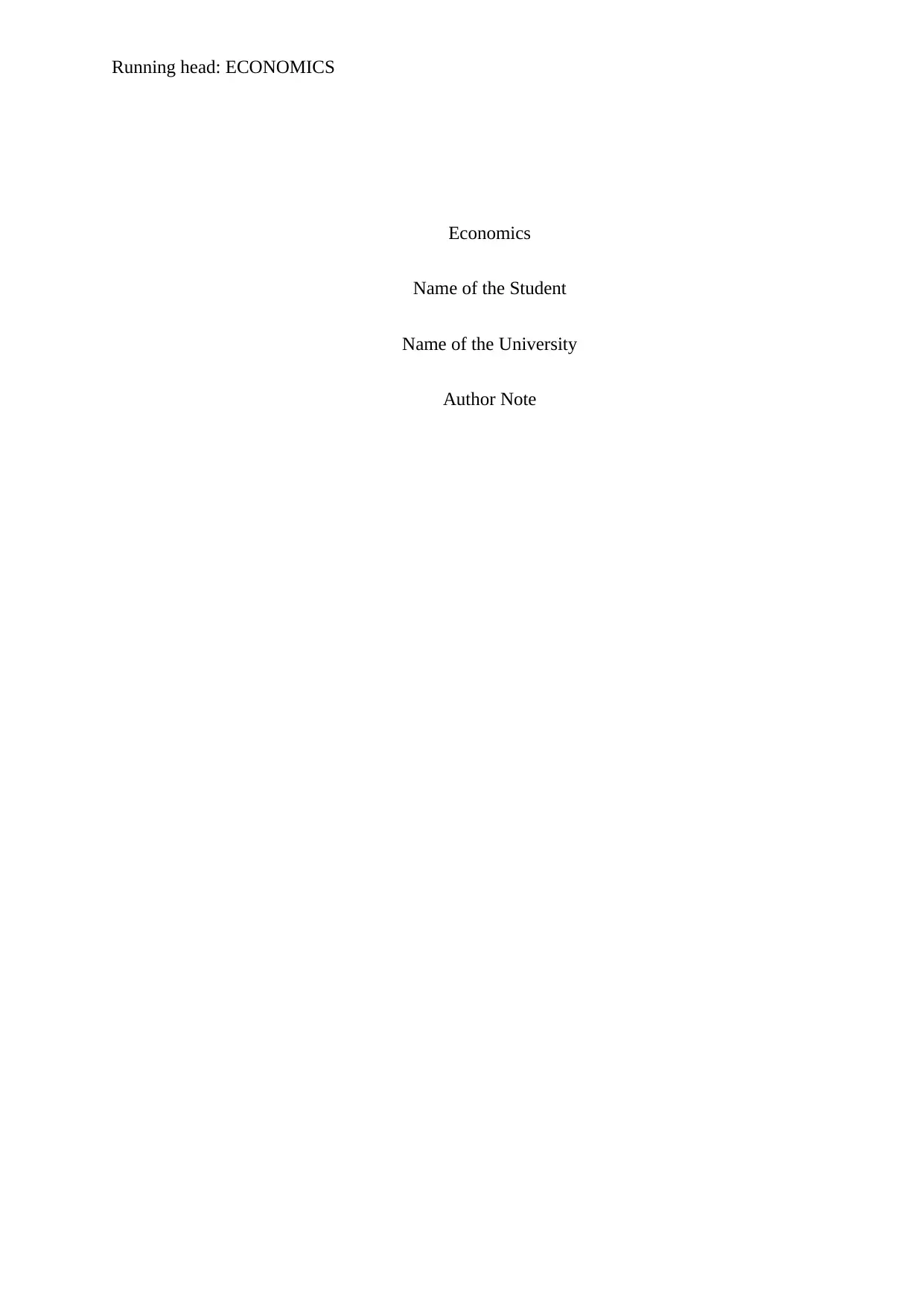
Running head: ECONOMICS
Economics
Name of the Student
Name of the University
Author Note
Economics
Name of the Student
Name of the University
Author Note
Paraphrase This Document
Need a fresh take? Get an instant paraphrase of this document with our AI Paraphraser
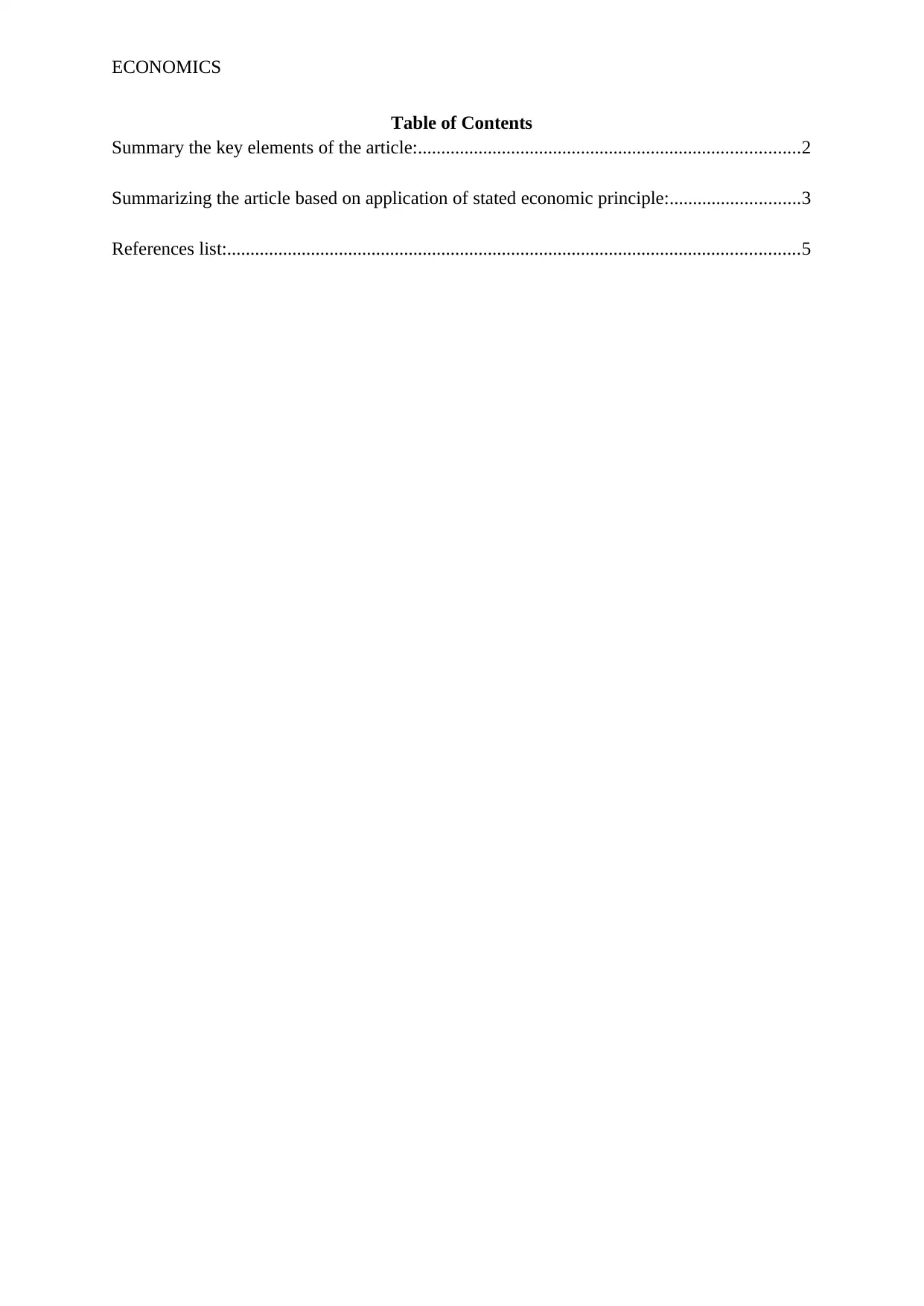
ECONOMICS
Table of Contents
Summary the key elements of the article:..................................................................................2
Summarizing the article based on application of stated economic principle:............................3
References list:...........................................................................................................................5
Table of Contents
Summary the key elements of the article:..................................................................................2
Summarizing the article based on application of stated economic principle:............................3
References list:...........................................................................................................................5
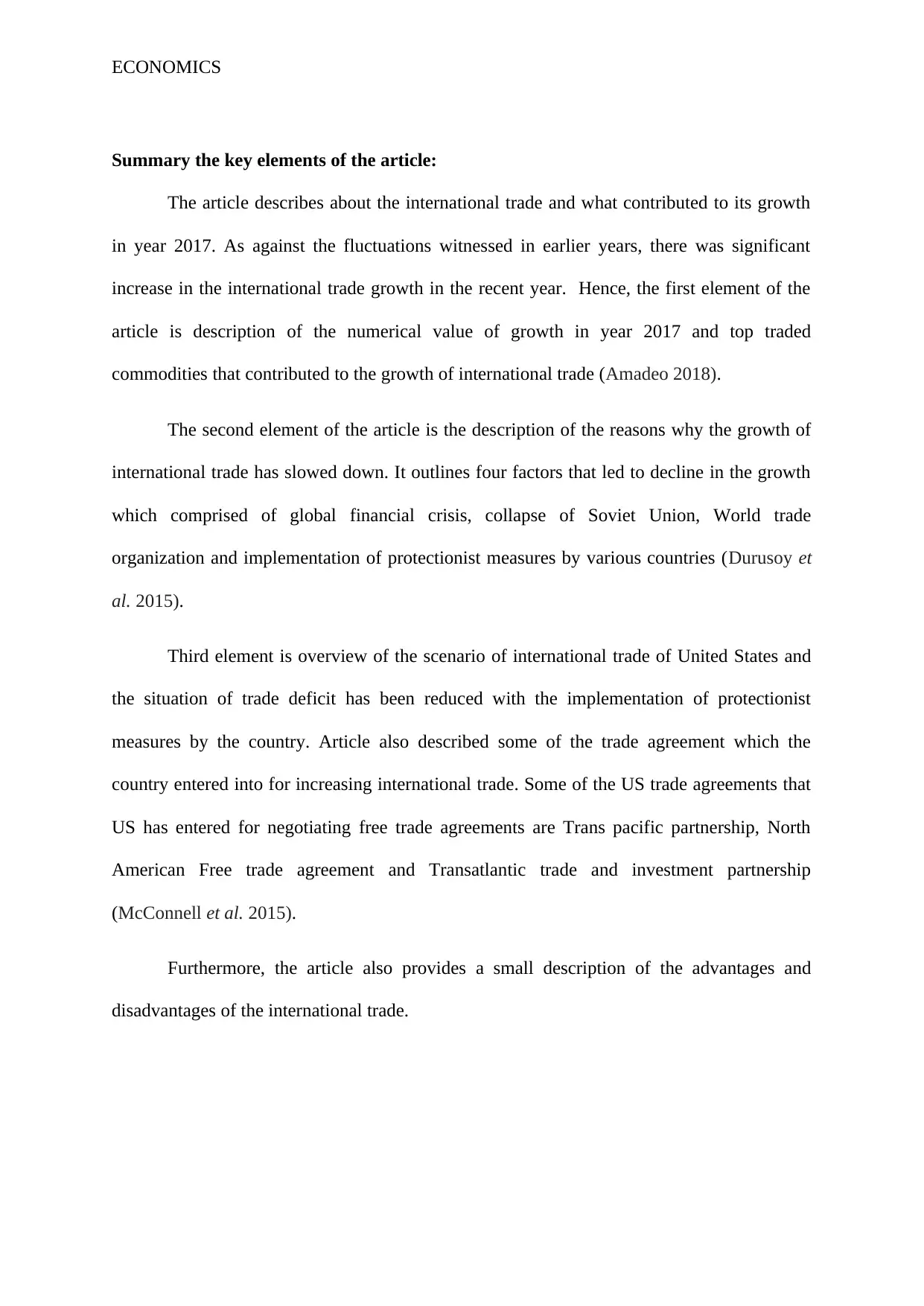
ECONOMICS
Summary the key elements of the article:
The article describes about the international trade and what contributed to its growth
in year 2017. As against the fluctuations witnessed in earlier years, there was significant
increase in the international trade growth in the recent year. Hence, the first element of the
article is description of the numerical value of growth in year 2017 and top traded
commodities that contributed to the growth of international trade (Amadeo 2018).
The second element of the article is the description of the reasons why the growth of
international trade has slowed down. It outlines four factors that led to decline in the growth
which comprised of global financial crisis, collapse of Soviet Union, World trade
organization and implementation of protectionist measures by various countries (Durusoy et
al. 2015).
Third element is overview of the scenario of international trade of United States and
the situation of trade deficit has been reduced with the implementation of protectionist
measures by the country. Article also described some of the trade agreement which the
country entered into for increasing international trade. Some of the US trade agreements that
US has entered for negotiating free trade agreements are Trans pacific partnership, North
American Free trade agreement and Transatlantic trade and investment partnership
(McConnell et al. 2015).
Furthermore, the article also provides a small description of the advantages and
disadvantages of the international trade.
Summary the key elements of the article:
The article describes about the international trade and what contributed to its growth
in year 2017. As against the fluctuations witnessed in earlier years, there was significant
increase in the international trade growth in the recent year. Hence, the first element of the
article is description of the numerical value of growth in year 2017 and top traded
commodities that contributed to the growth of international trade (Amadeo 2018).
The second element of the article is the description of the reasons why the growth of
international trade has slowed down. It outlines four factors that led to decline in the growth
which comprised of global financial crisis, collapse of Soviet Union, World trade
organization and implementation of protectionist measures by various countries (Durusoy et
al. 2015).
Third element is overview of the scenario of international trade of United States and
the situation of trade deficit has been reduced with the implementation of protectionist
measures by the country. Article also described some of the trade agreement which the
country entered into for increasing international trade. Some of the US trade agreements that
US has entered for negotiating free trade agreements are Trans pacific partnership, North
American Free trade agreement and Transatlantic trade and investment partnership
(McConnell et al. 2015).
Furthermore, the article also provides a small description of the advantages and
disadvantages of the international trade.
⊘ This is a preview!⊘
Do you want full access?
Subscribe today to unlock all pages.

Trusted by 1+ million students worldwide
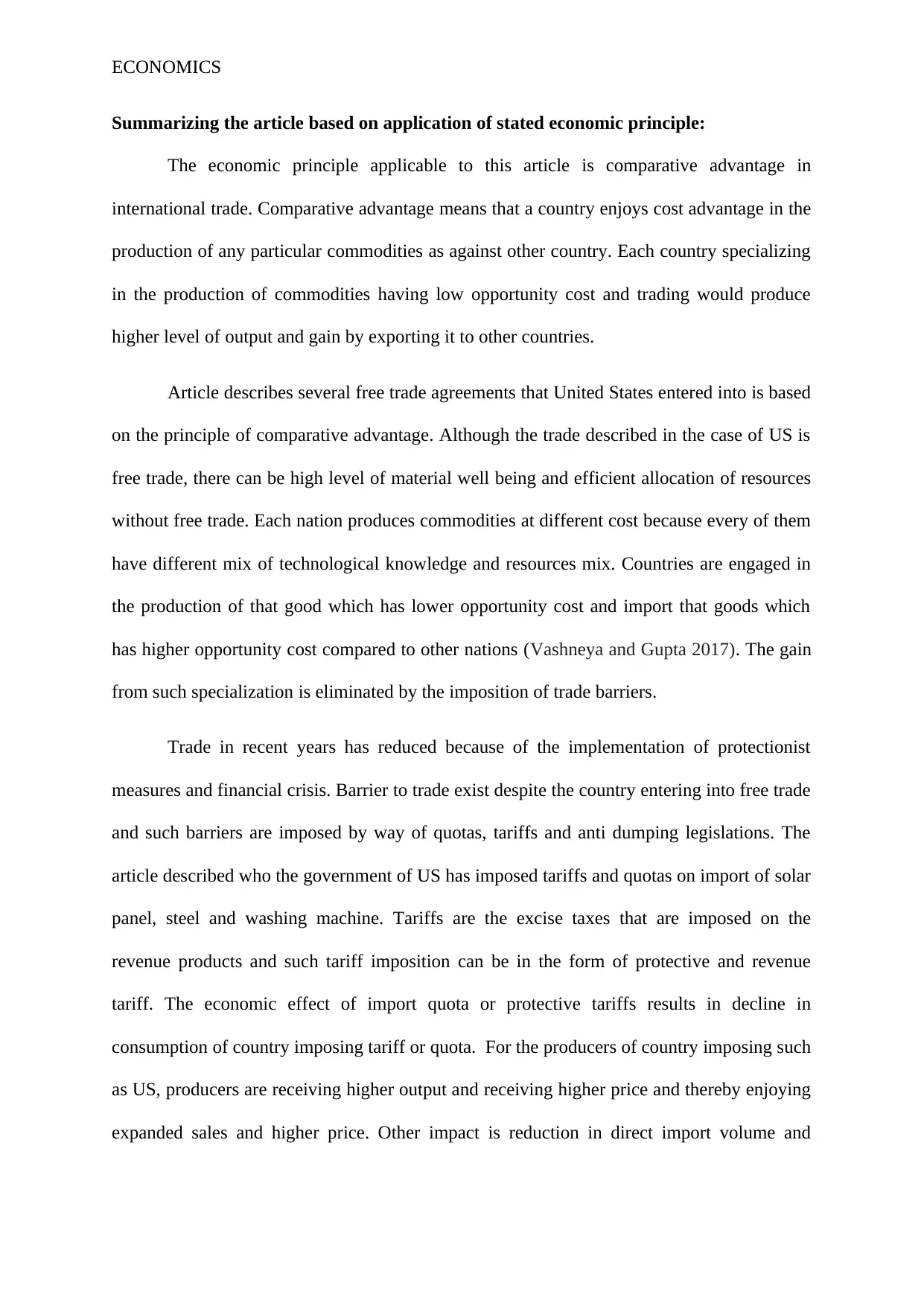
ECONOMICS
Summarizing the article based on application of stated economic principle:
The economic principle applicable to this article is comparative advantage in
international trade. Comparative advantage means that a country enjoys cost advantage in the
production of any particular commodities as against other country. Each country specializing
in the production of commodities having low opportunity cost and trading would produce
higher level of output and gain by exporting it to other countries.
Article describes several free trade agreements that United States entered into is based
on the principle of comparative advantage. Although the trade described in the case of US is
free trade, there can be high level of material well being and efficient allocation of resources
without free trade. Each nation produces commodities at different cost because every of them
have different mix of technological knowledge and resources mix. Countries are engaged in
the production of that good which has lower opportunity cost and import that goods which
has higher opportunity cost compared to other nations (Vashneya and Gupta 2017). The gain
from such specialization is eliminated by the imposition of trade barriers.
Trade in recent years has reduced because of the implementation of protectionist
measures and financial crisis. Barrier to trade exist despite the country entering into free trade
and such barriers are imposed by way of quotas, tariffs and anti dumping legislations. The
article described who the government of US has imposed tariffs and quotas on import of solar
panel, steel and washing machine. Tariffs are the excise taxes that are imposed on the
revenue products and such tariff imposition can be in the form of protective and revenue
tariff. The economic effect of import quota or protective tariffs results in decline in
consumption of country imposing tariff or quota. For the producers of country imposing such
as US, producers are receiving higher output and receiving higher price and thereby enjoying
expanded sales and higher price. Other impact is reduction in direct import volume and
Summarizing the article based on application of stated economic principle:
The economic principle applicable to this article is comparative advantage in
international trade. Comparative advantage means that a country enjoys cost advantage in the
production of any particular commodities as against other country. Each country specializing
in the production of commodities having low opportunity cost and trading would produce
higher level of output and gain by exporting it to other countries.
Article describes several free trade agreements that United States entered into is based
on the principle of comparative advantage. Although the trade described in the case of US is
free trade, there can be high level of material well being and efficient allocation of resources
without free trade. Each nation produces commodities at different cost because every of them
have different mix of technological knowledge and resources mix. Countries are engaged in
the production of that good which has lower opportunity cost and import that goods which
has higher opportunity cost compared to other nations (Vashneya and Gupta 2017). The gain
from such specialization is eliminated by the imposition of trade barriers.
Trade in recent years has reduced because of the implementation of protectionist
measures and financial crisis. Barrier to trade exist despite the country entering into free trade
and such barriers are imposed by way of quotas, tariffs and anti dumping legislations. The
article described who the government of US has imposed tariffs and quotas on import of solar
panel, steel and washing machine. Tariffs are the excise taxes that are imposed on the
revenue products and such tariff imposition can be in the form of protective and revenue
tariff. The economic effect of import quota or protective tariffs results in decline in
consumption of country imposing tariff or quota. For the producers of country imposing such
as US, producers are receiving higher output and receiving higher price and thereby enjoying
expanded sales and higher price. Other impact is reduction in direct import volume and
Paraphrase This Document
Need a fresh take? Get an instant paraphrase of this document with our AI Paraphraser
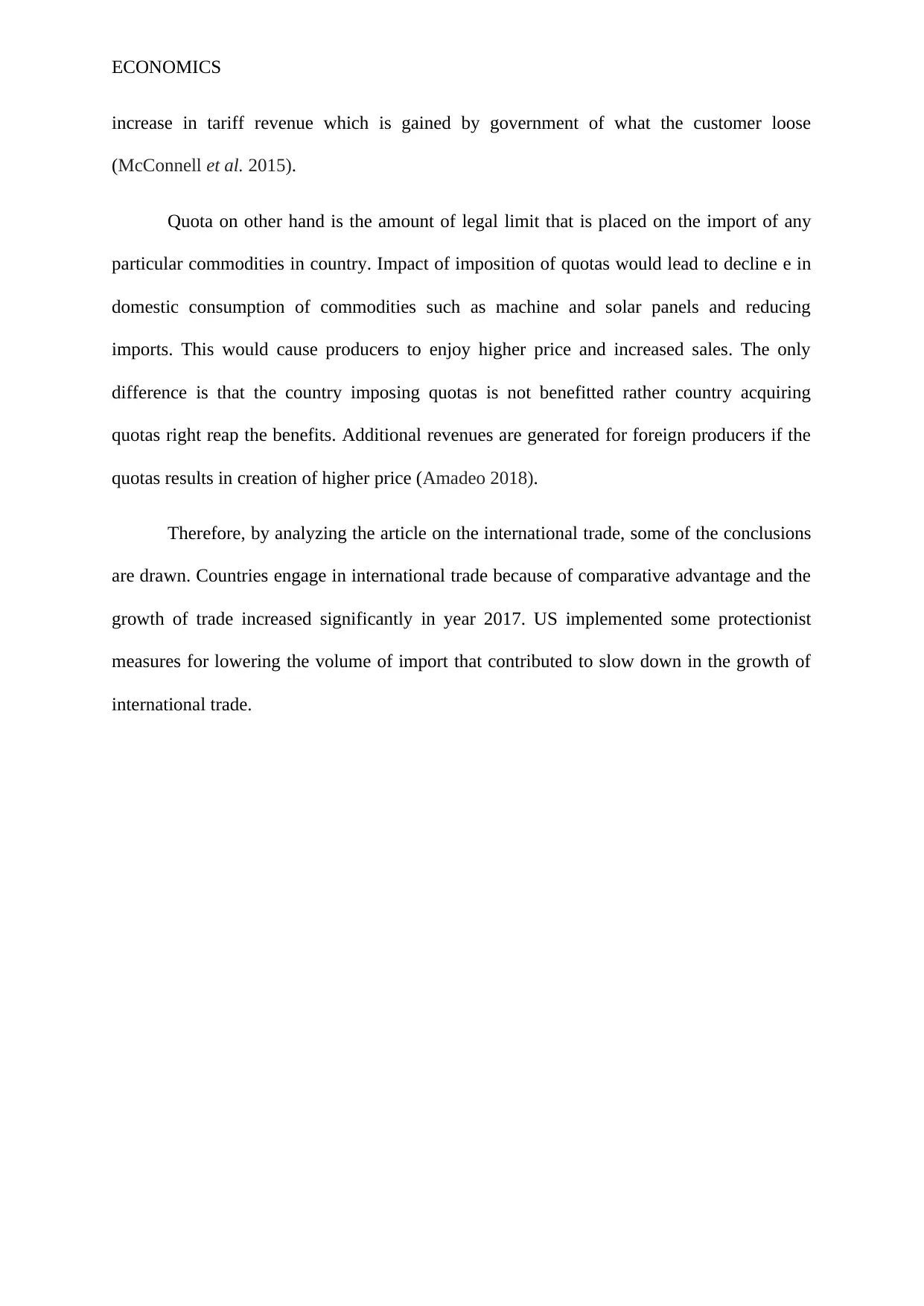
ECONOMICS
increase in tariff revenue which is gained by government of what the customer loose
(McConnell et al. 2015).
Quota on other hand is the amount of legal limit that is placed on the import of any
particular commodities in country. Impact of imposition of quotas would lead to decline e in
domestic consumption of commodities such as machine and solar panels and reducing
imports. This would cause producers to enjoy higher price and increased sales. The only
difference is that the country imposing quotas is not benefitted rather country acquiring
quotas right reap the benefits. Additional revenues are generated for foreign producers if the
quotas results in creation of higher price (Amadeo 2018).
Therefore, by analyzing the article on the international trade, some of the conclusions
are drawn. Countries engage in international trade because of comparative advantage and the
growth of trade increased significantly in year 2017. US implemented some protectionist
measures for lowering the volume of import that contributed to slow down in the growth of
international trade.
increase in tariff revenue which is gained by government of what the customer loose
(McConnell et al. 2015).
Quota on other hand is the amount of legal limit that is placed on the import of any
particular commodities in country. Impact of imposition of quotas would lead to decline e in
domestic consumption of commodities such as machine and solar panels and reducing
imports. This would cause producers to enjoy higher price and increased sales. The only
difference is that the country imposing quotas is not benefitted rather country acquiring
quotas right reap the benefits. Additional revenues are generated for foreign producers if the
quotas results in creation of higher price (Amadeo 2018).
Therefore, by analyzing the article on the international trade, some of the conclusions
are drawn. Countries engage in international trade because of comparative advantage and the
growth of trade increased significantly in year 2017. US implemented some protectionist
measures for lowering the volume of import that contributed to slow down in the growth of
international trade.
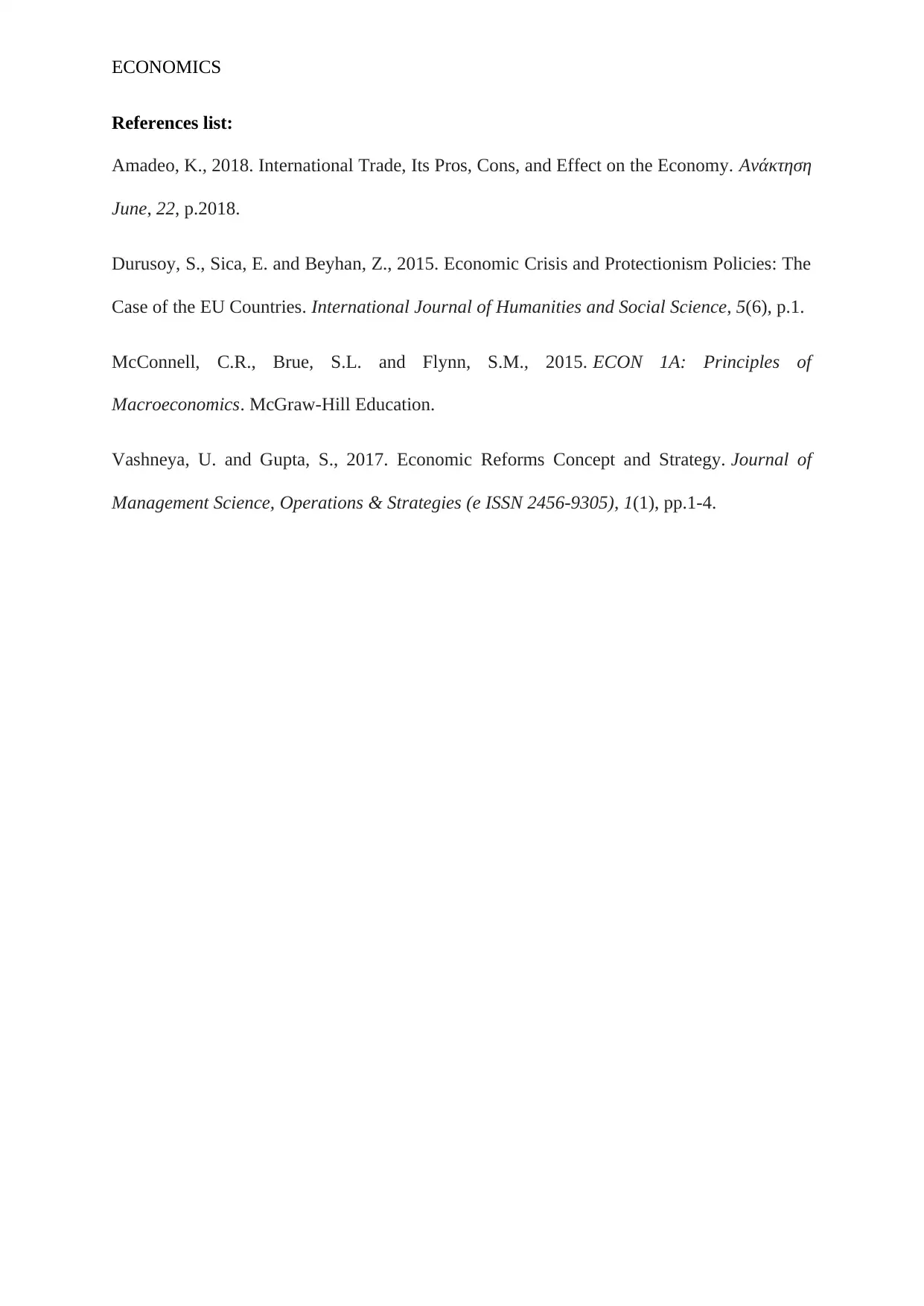
ECONOMICS
References list:
Amadeo, K., 2018. International Trade, Its Pros, Cons, and Effect on the Economy. Ανάκτηση
June, 22, p.2018.
Durusoy, S., Sica, E. and Beyhan, Z., 2015. Economic Crisis and Protectionism Policies: The
Case of the EU Countries. International Journal of Humanities and Social Science, 5(6), p.1.
McConnell, C.R., Brue, S.L. and Flynn, S.M., 2015. ECON 1A: Principles of
Macroeconomics. McGraw-Hill Education.
Vashneya, U. and Gupta, S., 2017. Economic Reforms Concept and Strategy. Journal of
Management Science, Operations & Strategies (e ISSN 2456-9305), 1(1), pp.1-4.
References list:
Amadeo, K., 2018. International Trade, Its Pros, Cons, and Effect on the Economy. Ανάκτηση
June, 22, p.2018.
Durusoy, S., Sica, E. and Beyhan, Z., 2015. Economic Crisis and Protectionism Policies: The
Case of the EU Countries. International Journal of Humanities and Social Science, 5(6), p.1.
McConnell, C.R., Brue, S.L. and Flynn, S.M., 2015. ECON 1A: Principles of
Macroeconomics. McGraw-Hill Education.
Vashneya, U. and Gupta, S., 2017. Economic Reforms Concept and Strategy. Journal of
Management Science, Operations & Strategies (e ISSN 2456-9305), 1(1), pp.1-4.
⊘ This is a preview!⊘
Do you want full access?
Subscribe today to unlock all pages.

Trusted by 1+ million students worldwide

ECONOMICS
1 out of 7
Related Documents
Your All-in-One AI-Powered Toolkit for Academic Success.
+13062052269
info@desklib.com
Available 24*7 on WhatsApp / Email
![[object Object]](/_next/static/media/star-bottom.7253800d.svg)
Unlock your academic potential
Copyright © 2020–2025 A2Z Services. All Rights Reserved. Developed and managed by ZUCOL.




